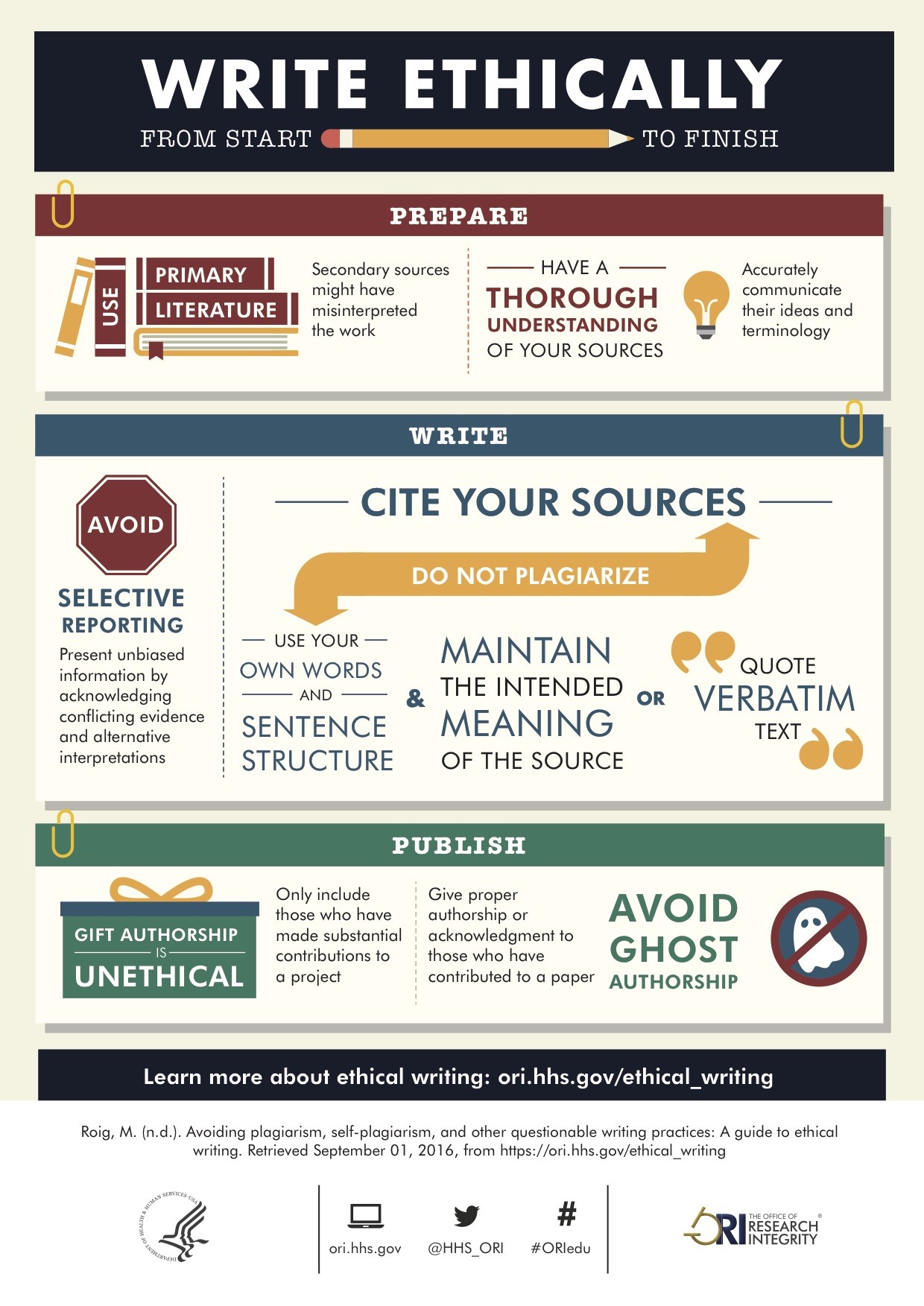Manuscript Preparation
Manuscript preparation requires organization of data, references, collaboration with co-authors and an understanding of copyright and access to manuscripts. These resources are to help researchers organize their data, identify potential ways co-authors can seamlessly share data and manuscript drafts, and resources to understand copyright and public access to publications (for more information on public access mandates visit Public Access Mandates webpage).
Accidental plagiarism is often the result of poor note taking or improperly citing a reference when paraphrasing (read about: Confessions of an Accidental Plagiarist). Below are some resources for avoiding plagiarism and managing citations.
Understanding What Plagiarism Is and How to Avoid It
- Columbia’s Graduate School of Arts and Sciences website on academic integrity has compiled several of these: GSAS Resources
- Indiana University has created comprehensive tutorials and an exam regarding plagiarism. The exam may be a useful risk assessment tool. (Indiana University Resources)
- 28 Guidelines at a Glance from ORI
- Knowing and Avoiding Plagiarism During Scientific Writing by P. Mohan Kumar et. al.
Manage Sources and Citations Systematically
Sometimes plagiarism results from mismanaged or improper citation and source management. Citation management software can help avoid such problems. These tools help researchers keep track of sources and citations. Below are Columbia University resources for managing citations (many are free with Columbia UNI).
Software providers offer tutorials to help troubleshoot and utilize software to full potential:
Tutorials for using F1000 Workspace
For information on plagiarism in the context of research misconduct, please see RCT's misconduct webpage.
-
Rascal Course: Handling Digital Scientific Images: Dos & Don’ts | The course addresses the ethical considerations and challenges of digital image manipulation in scientific research. It covers the importance of using image editing responsibly to enhance clarity without compromising data integrity. The curriculum is divided into modules (TC7150 & TC7151) focusing on ethical image handling practices, acceptable versus unacceptable modifications, and the management of digital images to maintain traceability and compliance. Additionally, it delves into the detection of improper image manipulations, the classification of these alterations, and the emerging challenges posed by generative AI technologies in scientific imagery.
-
Avoiding Twisted Pixels: Ethical Guidelines for the Appropriate use and Manipulation of Scientific Digital Images By Douglas Cromey
-
What's in a Picture? The Temptation of Image Manipulation by Mike Rossner and Kenneth M. Yamada [Specific for blots, gels, and micrographs]
-
Analysis and Correction of Inappropriate Image Duplication: the Molecular and Cellular Biology Experience by Elisabeth M. Bik, et. al.
- Name
- LabArchives
- Description and Features
- Electronic Lab Notebook
- Free for any Columbia personnel with a valid UNI
- Includes controlled access
- Notebooks can be shared with individuals outside Columbia
- Version control
- Name
- Open Science Framework
- Description and Features
- A cloud-based collaboration platform
- Includes controlled access and version control
-
Questionnaire to determine the right reporting checklist for your work from the EQUATOR library
-
Instant feedback for your manuscript from Penelope - checks academic manuscripts written in Microsoft Word. In seconds, it assesses structure, declarations, statistics, referencing and other common reporting errors.
-
Principles and Guidelines for Reporting Preclinical Research from NIH
-
ARRIVE Guidelines (Animal Research: Reporting of In Vivo Experiments) The ARRIVE guidelines, originally published in PLOS Biology, were developed in consultation with the scientific community as part of an NC3Rs initiative to improve the standard of reporting of research using animals.
-
Research Reporting Guidelines and Initiatives: By Organization - This chart lists the major biomedical research reporting guidelines that provide advice for reporting research methods and findings (from NIH - NLM)
Columbia University Copyright Advisory Services is able to address issues surrounding the use of scholarly materials by faculty and students in the course of research, teaching and communicating scholarship.
Predatory journals and publishers often operate under the auspices of open-access publishing. They charge authors fees without reviewing research for quality or providing editorial and publishing services. Below are questions and resources to help you determine if a journal is predatory.
- If the journal is open access, is it registered with the Directory of Open Access Journals?
- Does the journal list the names of its editorial and advisory boards?
- Are the journal's peer review and editorial policies openly available?
- Do you recognize the names of current contributors as scholars in your field?
- Do you recognize the publisher of the journal? Is this information easy to find? Is that publisher a member of COPE (the Committee on Publication Ethics)?
Columbia University Libraries Scholarly Communication is available to help! Email questions to: [email protected]
Resources
- Columbia Libraries Scholarly Communication Website on Publishing
- Think. Check. Submit. helps researchers identify trusted journals for their research.Through a range of tools and practical resources, this international, cross-sector initiative aims to educate researchers, promote integrity, and build trust in credible research and publications.
Literature
- “Predatory” vs trustworthy journals: What do they mean for the integrity of science? by Sacha Boucherie
- Academics and scientists: Beware of predatory journal publishers from Federal Trade Commission
- Beware of predatory journals by Anders Rydholm
-
How I became easy prey to a predatory publisher by Alan H. Chambers
- What Constitutes Authorship? A discussion document for authorship from COPE
- NIH Guidelines for authorship


